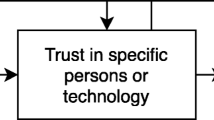Abstract
The scientific research in the area of computational mechanisms for trust and reputation in virtual societies is a recent discipline oriented to increase the reliability and performance of electronic communities. Computer science has moved from the paradigm of isolated machines to the paradigm of networks and distributed computing. Likewise, artificial intelligence is quickly moving from the paradigm of isolated and non-situated intelligence to the paradigm of situated, social and collective intelligence. The new paradigm of the so called intelligent or autonomous agents and multi-agent systems (MAS) together with the spectacular emergence of the information society technologies (specially reflected by the popularization of electronic commerce) are responsible for the increasing interest on trust and reputation mechanisms applied to electronic societies. This review wants to offer a panoramic view on current computational trust and reputation models.
Similar content being viewed by others
References
Abdul-Rahman, A. & Hailes, S. (2000). Supporting Trust in Virtual Communities. Proceedings of the Hawaii’s International Conference on Systems Sciences, Maui, Hawaii.
Amazon (2002). Amazon Auctions. http://auctions.amazon.com.
Bacharach, M. & Gambetta, D. (2001). Trust in Society, Chapt. Trust in signs. Russell Sage Foundation.
Barber, K. S. & Kim, J. (2001). Belief Revision Process based on Trust: Simulation Experiment. In: Proceedings of the Fourth Workshop on Deception, Fraud and Trust in Agent Societies, Montreal, Canada. pp. 1--12.
Bromley, D. B. (1993). Reputation, Image and Impression Management. John Wiley & Sons.
V. Buskens (1998) ArticleTitleThe Social Structure of Trust Social Networks 20 265–298
Carbo, J., Molina, J. & Davila, J. (2002). Comparing Predictions of SPORAS vs. a Fuzzy Reputation Agent System. In: Third International Conference on Fuzzy Sets and Fuzzy Systems, Interlaken. pp. 147--153.
J. Carter E. Bitting A. Ghorbani (2002) ArticleTitleReputation Formalization for an Information-Sharing Multi-Agent Sytem Computational Intelligence 18 IssueID2 515–534
Castelfranchi, C. & Falcone, R. (1998). Principles of Trust for MAS: Cognitive Anatomy, Social Importance, and Quantification. In: Proceedings of the International Conference on Multi-Agent Systems (ICMAS’98), Paris, France. pp. 72--79.
Castelfranchi, C. & Tan, Y.-H. (2001). Trust and Deception in Virtual Societies. Kluwer Academic Publishers.
M. Celentani D. Fudenberg D. K. Levine W. Psendorfer (1966) ArticleTitleMaintaining a Reputation Against a Long-Lived Opponent Econometrica 64 IssueID3 691–704
Conte, R. & Paolucci, M. (2002). Reputation in Artificial Societies: Social Beliefs for Social Order. Kluwer Academic Publishers.
Dellarocas, C. (2003). The digitalization of Word-Of-Mouth: Promise and Challenges of Online Reputation Mechanisms. Management Science.
eBay. (2002). eBay. http://www.eBay.com.
Esfandiari, B. & Chandrasekharan, S. (2001). On How Agents Make friends: Mechanisms for Trust Acquisition. In: Proceedings of the Fourth Workshop on Deception, Fraud and Trust in Agent Societies, Montreal, Canada. pp. 27--34.
D. Gambetta (1990) Trust: Making and Breaking Cooperative Relations, Chapt. Can We Trust Trust? Basil Blackwell Oxford 213–237
M. E. Glickman (1999) ArticleTitleParameter Estimation in Large Dynamic Paired Comparison Experiments Applied Statistics 48 377–394
Grandison, T. & Sloman, M. (2000). A survey of trust in Internet application, IEEE, Communications Surveys, Fourth Quarter, 2000.
D. Hume (1975) A Treatise of Human Nature (1737) Oxford Clarendon Press
Karlins, M. & Abelson, H. I. (1970). Persuasion, how opinion and attitudes are changed. Crosby Lockwood & Son.
Lashkari, Y., Metral, M. & Maes, P. (1994). Collaborative Interface Agents. In: Proceedings of the Twelfth National Conference on Artificial Intelligence, AAAI-Press.
Marimon, R., Nicolini, J. P. & Teles, P. (2000). Competition and Reputation. In: Proceedings of the World Conference Econometric Society, Seattle.
Marsh, S. (1994). Formalising Trust as a Computational Concept. Ph.D. thesis, Department of Mathematics and Computer Science, University of Stirling.
McKnight, D. H. & Chervany, N. L. (1996). The meanings of trust. Technical report, University of Minnesota Management Information Systems Research Center.
McKnight, D. H. & Chervany, N. L. (2002). Notions of Reputation in Multi-Agent Systems: A Review. In: Proceedings of the 34th Hawaii International Conference on System Sciences.
Montaner, M., Lopez, B. & de la Rosa, J. (2002). Developing Turst in Recommender Agents. In: Proceedings of the First International Joint Conference on Autonomous Agents and Multiagent Systems (AAMAS-02), Bologna, Italy. pp. 304--305.
Mui, L., Halberstadt, A. & Mohtashemi, M. (2002). Notions of Reputation in Multi-Agent Systems: A Review. In: Proceedings of the First International Joint Conference on Autonomous Agents and Multiagent Systems (AAMAS-02), Bologna, Italy. pp. 280--287.
OnSale (2002). OnSale. http://www.onsale.com.
Pearl, J. (1988). Probabilistic Reasoning in Intelligent Systems: Networks of Plausible Inference. Morgan Kaufmann.
Plato (1955). The Republic (370BC). Viking Press.
Sabater, J. & Sierra, C. (2001). REGRET: A Reputation Model for Gregarious Societies. In: Proceedings of the Fourth Workshop on Deception, Fraud and Trust in Agent Societies, Montreal, Canada. pp. 61--69.
Sabater, J. & Sierra, C. (2002). Reputation and Social Network Analysis in Multi-Agent Systems. In: Proceedings of the First International Joint Conference on Autonomous Agents and Multiagent Systems (AAMAS-02), Bologna, Italy. pp. 475--482.
Schillo, M., Funk, P. & Rovatsos, M. (2000). Using Trust for Detecting Deceitful Agents in Artificial Societites. Applied Artificial Intelligence (Special Issue on Trust, Deception and Fraud in Agent Societies).
Scott, J. (2000). Social Network Analysis. SAGE Publications.
Sen, S. & Sajja, N. (2002). Robustness of Reputation-based Trust: Booblean Case. In: Proceedings of the First International Joint Conference on Autonomous Agents and Multiagent Systems (AAMAS-02), Bologna, Italy. pp. 288--293.
UCI (2003). UCI Machine Learning Repository. http:www.ics.uci.edu/~mlearn/MLRepository.html.
Yu, B. & Singh, M. P. (2001). Towards a Probabilistic Model of Distributed Reputation Management. In: Proceedings of the Fourth Workshop on Deception, Fraud and Trust in Agent Societies, Montreal, Canada. pp. 125--137.
B. Yu M. P. Singh (2002a) ArticleTitleDistributed Reputation Management for Electronic Commerce Computational Intelligence 18 IssueID4 535–549
Yu, B. & Singh, M. P. (2002b). An Evidential Model of Distributed Reputation Management. In: Proceedings of the First International Joint Conference on Autonomous Agents and Multiagent Systems (AAMAS-02), Bologna, Italy. pp. 294--301.
Zacharia, G. (1999). Collaborative Reputation Mechanisms for Online Communities. Master’s thesis, Massachusetts Institute of Technology.
Author information
Authors and Affiliations
Corresponding author
Rights and permissions
About this article
Cite this article
Sabater, J., Sierra, C. Review on Computational Trust and Reputation Models. Artif Intell Rev 24, 33–60 (2005). https://doi.org/10.1007/s10462-004-0041-5
Issue Date:
DOI: https://doi.org/10.1007/s10462-004-0041-5




